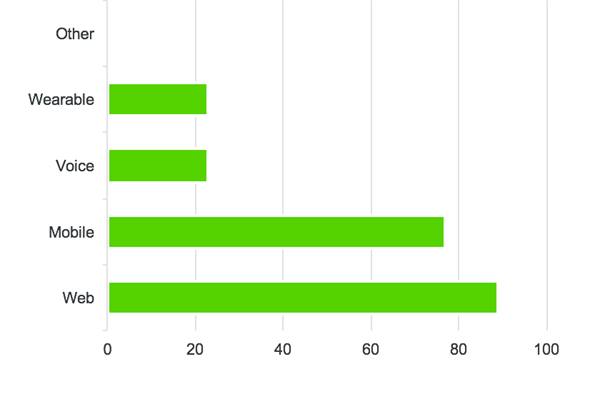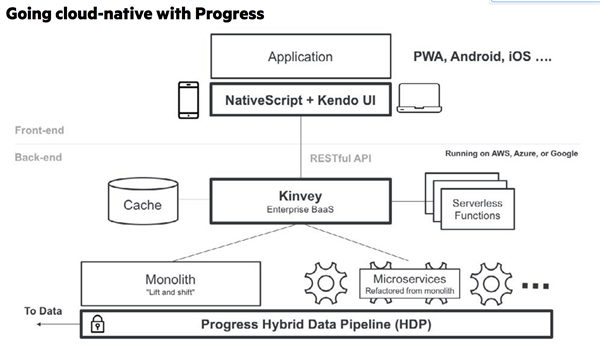S
Sumit Sarkar
Guest
Learn about modernizing your existing legacy monoliths to support multi-channel app experiences across web, mobile, AR/VR, voice and wearables.
There are a lot of articles out there on migrating to cloud-native architectures and microservices from a monolithic application, but most have very little detail on exactly how to achieve this in production environments. Progress CTO, Dmitri Tcherevik, hosted a webinar to address real questions from information technology leaders directly. Below are the enterprise architecture considerations that were discussed for modernizing monoliths that were discussed:
The webinar included live polls of enterprise architects, IT directors, CTOs and CIOs who shared insights about different modes of engagement and monolith technologies in production. When it came to frontend platform support, I was impressed with the traction of wearables and voice in the enterprise. In the second question, 17% selected other for monolith technologies beyond Java and .NET, which will require flexible data access and security strategies to support the journey for all of these systems.
Q1. What frontend platforms do you support?

Q2. What technology is your monolith built on?

Monolith Modernization Journey
The monolith modernization journey includes migrating to the cloud, abstracting the monolith with BaaS + API Gateway and finally strangling the monolith by building scalable microservices to migrate slices of functionality behind the abstraction. Strangling your applications may sound violent, but it will make it stronger by supporting modern experiences at cloud scale.
The end result is a reference architecture that shows how Progress can uniquely support the elusive journey to cloud native architectures.

Sample Questions Addressed Live from the Webinar
Check out the webinar to hear these questions answered live:
To learn more about modernizing existing legacy systems to support modern app experiences, download a playbook at the link below, or contact us if you’re ready to discuss how Progress can help.
Learn More
Continue reading...
There are a lot of articles out there on migrating to cloud-native architectures and microservices from a monolithic application, but most have very little detail on exactly how to achieve this in production environments. Progress CTO, Dmitri Tcherevik, hosted a webinar to address real questions from information technology leaders directly. Below are the enterprise architecture considerations that were discussed for modernizing monoliths that were discussed:
- Prepare for upcoming multi-channel experiences from chatbots to VR
- Deliver new digital capabilities while also modernizing existing systems
- Implement cloud-native, serverless technologies to decrease delivery times and costs
- Meet data governance, security and compliance requirements without sacrificing speed and agility
- Deliver native experiences quickly across all touchpoints by standardizing and reusing code
The webinar included live polls of enterprise architects, IT directors, CTOs and CIOs who shared insights about different modes of engagement and monolith technologies in production. When it came to frontend platform support, I was impressed with the traction of wearables and voice in the enterprise. In the second question, 17% selected other for monolith technologies beyond Java and .NET, which will require flexible data access and security strategies to support the journey for all of these systems.
Q1. What frontend platforms do you support?

Q2. What technology is your monolith built on?

Monolith Modernization Journey
The monolith modernization journey includes migrating to the cloud, abstracting the monolith with BaaS + API Gateway and finally strangling the monolith by building scalable microservices to migrate slices of functionality behind the abstraction. Strangling your applications may sound violent, but it will make it stronger by supporting modern experiences at cloud scale.
The end result is a reference architecture that shows how Progress can uniquely support the elusive journey to cloud native architectures.

Sample Questions Addressed Live from the Webinar
Check out the webinar to hear these questions answered live:
- Could you say a few more details about the Hybrid Data Pipeline that would allow nervous financial services companies to consider it?
- How is the frontend of the monolith application exposed via the cloud? How is the BaaS connect with the monolith system. In other words what changes are needed on the monolith application to support this?
- Do you also offer / recommend any end to end monitoring tools to ensure the overall system is operating efficiently?
- Does NativeScript then compile into native code for each of the mobile OS platform?
- Can a BaaS replace a microservices architecture?
- How do you best determine the granularity of microservices so that it is manageable and yet small enough and distinct with no overlaps?
- When we break the monolith to microservices what toolsets / governance process are recommended to orchestrate N number of microservices now, that might get out of control if not governed properly
- Architecture considerations for offline support Mobile applications?
- With an increase in the use of microservices is there a heightened risk of communication failures between different services causing issues with the applications.
- What is the strategy for separating out monolith to microservices?
- How do you overcome the cultural resistance of a conservative, predominantly on-prem and private cloud IT department?
- What security encryption do you have between your NativeScript SDK and API Gateway?
- Does NativeScript then compile into native code for each of the mobile OS platform
- How does NativeScript handle UI differences across different platforms? e.g. native ui differences between ios/android
- Does Knivey have integrations with leading CI/CD tools?
To learn more about modernizing existing legacy systems to support modern app experiences, download a playbook at the link below, or contact us if you’re ready to discuss how Progress can help.
Learn More
Continue reading...
